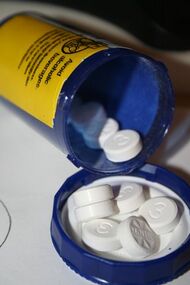Chemistry:Co-codamol
 | |
| Combination of | |
|---|---|
| Codeine | Opioid analgesic |
| Paracetamol | Anilide analgesic |
| Clinical data | |
| Pregnancy category |
|
| Routes of administration | Oral |
| ATC code | |
| Legal status | |
| Legal status |
|
| Identifiers | |
| PubChem CID | |
| ChemSpider | |
| | |
Codeine/acetaminophen or co-codamol (BAN) is a compound analgesic consisting of a combination of codeine phosphate and paracetamol (acetaminophen). Co-codamol tablets are used for the relief of mild to moderate pain when paracetamol or NSAIDs such as ibuprofen, aspirin or naproxen alone do not sufficiently relieve a patient's symptoms, or where their use is ill-advised.
Co-codamol is marketed under various brand names in addition to the generic name.
Formulations
Seven strengths are available:
- 8 mg of codeine phosphate per tablet (e.g. Tylenol 1 in US/Canada)
- 10 mg of codeine phosphate per tablet
- 12.8 mg of codeine phosphate per tablet
- 15 mg of codeine phosphate per tablet (e.g. brands Tylenol 2 in US/Canada, Norway, Australia (multiple brands), United Kingdom)
- 20 mg of codeine phosphate per tablet (Prontalgine in France, Empacod, South Africa and Zimbabwe)
- 30 mg of codeine phosphate per tablet (e.g. Tylenol 3 in US/Canada, ratio-Emtec-30 or "Emtec" in Canada, available elsewhere in capsules such as Tylex or in tablets/caplets e.g. Solpadol, Kapake, Panacod and Zapain).
- 60 mg of codeine phosphate per tablet (e.g. Tylenol 4 in US/Canada, and generally contain from 300 mg to 1000 mg), 1 gram of paracetamol per tablet.[1]
Combination products containing codeine are available over the counter only in Barbados, United Kingdom , Canada , New Zealand, Poland , Israel, Latvia, Estonia and Costa Rica and Spain [2].
In the United Kingdom and Ireland the 15/500 and 30/500 tablets are available only with a prescription, although the 8/500 and 12.8/500 strengths are available over-the-counter. In Australia the 30/500 tablets are available only with a prescription, and the 10/500 and 15/500 tablets were Schedule 3 (Pharmacist Only Medicine) until February 1st 2018 after which they were rescheduled to S4 (prescription only) along with all other codeine products. Manufacturer directions state not to exceed more than the recommended dosage of two tablets every four hours with a maximum of eight (8 × 500 mg) over a 24-hour period and no more than two (2 × 500 mg) at any one time. Other drugs containing paracetamol must be avoided unless otherwise directed by a physician or pharmacist; excessive amounts of paracetamol can lead to serious liver damage. See Paracetamol toxicity.
Co-codamol is marketed in Canada and the United States also under the generic name "Atasol Codeine". In the UK it is marketed as "Solpadeine Plus" and "Solpadeine Max", as well as "Solpadol". In Australia it is marketed as "Panadeine", "Panadeine Extra" and "Panadeine Forte". Co-codamol is sold as "Paralgin Minor" (15/200) (not available as of 2015), "Paralgin Forte" (30/400), "Paralgin Major" (60/800), "Pinex Forte" (30/500) and "Pinex Major" (60/1000) in Norway .
Side effects of co-codamol
Side effects can include blood from mouth, skin rashes, dizziness, sedation, shortness of breath, hypersensitivity reaction, fainting (syncope or near syncope), nausea and/or vomiting, confusion, loss of short-term memory, drowsiness, changes in blood, allergic reactions, euphoria, dysphoria, abdominal pain, pruritus (itching), easy bruising, bleeding gums, vivid dreams, dry mouth and addiction.
Genetic differences between people give rise to differing rates of metabolism of codeine to morphine. In about 5% of people this may happen particularly fast, leading to higher levels of morphine being passed through breast milk in amounts potentially able to cause fatal respiratory depression of a breastfed baby.[3]
See also
- Co-codaprin
- Co-dydramol
- Co-proxamol
References
- ↑ Tylenol with Codeine, from Drugs.com
- ↑ Health risks from codeine based medicines - Whelehan's Pharmacy
- ↑ CTV News, Codeine use while breastfeeding may be dangerous, Wed. Aug. 20, 2008


